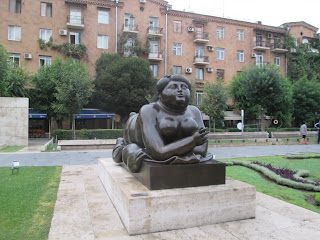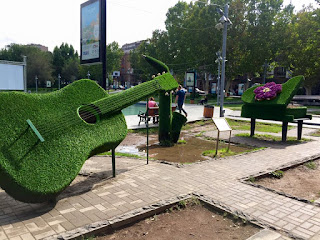 |
| Our hotel, with cafe on back patio, overlooking one of many mosques in Istanbul |
Amanda, Matt, cousin Mariann, and I left Georgia to tour Istanbul, one of Mariann's favorite places. so she was our guide. It was absolutely beautiful, with a fascinating history. And she was an EXCELLENT tour guide!
In fact, one can't really appreciate Istanbul without understanding its history. Who's on First, as it were. So I hope you don't mind if I add some history to help add context to our travels. Reference Wikipedia and
this hotel.
What is now called Istanbul
has been populated since Neolithic times, with the earliest settlement dating
back to 6700 B.C. We also know that the
very first settlement on the Anatolian side goes back to the Copper Age, where
artifacts have been found dating from 5500 to 3500 B.C. Beginning as a Greek colony in 7th Century B.C known as Byzantium,
the city began to grow on the site of a port settlement founded at the entrance to the Bosporous and Black Sea.
 |
| Our ferry ride across the Bosporous. |
Byzantium fell
to the Roman Republic
in 196 A.D. and was renamed Constantinople after
Constantine the Great in 324 A.D. (I read an interesting article that share how Constantine's conversion on his death bed was really politically motivated, duh!). A capitol now devoted to the Roman Empire,
it favored Christianity and became a famed religious center. After the city split with Rome,
it became the center of Greek Orthodox Christianity and Greek culture, under
the dominance of Byzantine emperor, Justinian. They brought back the Byzantine designation to differentiate themselves from the Romans. Erecting many great churches,
including the Hagia Sophia, the years 527 to 565 it saw the extension of the
empire from Palestine to the tip of
Spain, creating
a great influence on the capital city.
Ottoman Empire: Constantinople continued to thrive
until 1204 when the Crusaders conquered the city for the first time and ransacked it. After a decline,
it finally began a new life once again as Capitol of the Ottoman Empire under Sultan Mehmed II with the Muslim conquest in 1453. “The Conqueror” began a 53 day siege. Mehmed II subsequently turned the Hagia
Sophia into a Turkish mosque, and rebuilt the destroyed city into a primarily Muslim culture. It became the 3rd Capitol of the Ottoman Empire.
Here we are at the Hagia Sophia - first a Christian Basilica in 527 A.D. , then The Ottoman's mosque in 1453, now a museum to keep everyone happy (or not... Since Pope Francis recognized the Armenian Genocide by the Turks in 1915, there has been heightened pressure to turn this back into a mosque). But nevertheless, it is beautiful. As a museum the carpets were removed and the marble floor decorations appeared for the first time in centuries, while the white
plaster covering many of the mosaics was removed. Much renovation continues.
 |
| our tour guide! |
 |
| Byzantine Mary holding Christ - from 1122. |
"What happened to the Sultans," I kept asking? I heard about their presence all over Istanbul, but never understood why they disappeared. Answer - the Ottoman Empire entered into World War I along the Central Powers in
1914. With their loss, and eventually, in
November 1922, the Ottomans Sultanate was abolished and thus ended the
Ottoman Empire, which had lasted since 1299. It was an amazing story of a family or lineage that had ruled 623 years. Sort of puts our US Bicentennial into perspective! Next we visited the Topkapi Palace, where the Sultan's family lived from 1456 to 1865. It looked so comfortable!

 |
| Lounging room |
Next we ventured over to the Blue Mosque....
 |
| Hard to keep everything straight after a while |

...followed by touring the The Basilica Cistern, which is the largest of several
hundred ancient cisterns that lie beneath the city. The cistern provided a
water filtration system for the Great Palace of Constantinople, and continued
to provide water to the
Topkapi Palace
after the Ottoman conquest in 1453 and into modern times. It is about 105,000
sq ft in area – capable of holding 2,800,000 cu ft of water. The ceiling is
supported by a forest of 336 marble columns, each 30 ft high,
arranged in 12 rows of 28 columns each spaced 16 ft apart. The
capitals of the columns are mainly Ionic and Corinthian styles. One of the columns is
engraved with raised pictures of a Hen's Eye, slanted braches, and tears. Ancient
texts suggest that the tears on the column pay tribute to the hundreds of
slaves who died during the construction of the Basilica Cistern. Historical texts claim that 7,000 slaves were
involved in its construction.
 |
| I couldn't help myself. After all those years of passing up on these goofy pictures, I insisted we take one in the Cistern. Plus it was cool down there after a hot day. |

The majority of the
columns in the cistern appear to have been recycled from the ruins of older
buildings (a process called 'spoliation'), likely brought to
Constantinople
from various parts of the empire, together with those that were used in the
construction of Hagia Sophia. They are carved and engraved out of various types
of marble and granite. We could walk all around the cistern on docks, see the fish swimming and note the various column types and differences. Really beautiful.
In 1930,
under
Mustafa Kemal Ataturk, Istanbul
became the official name of the city. Ataturk is a real hero for many Turks. He is credited with being the founder of the
Republic
of Turkey in 1923 and it's first President, after fighting to gain
control of the country from the Allies after WWI. His surname, Atatürk
(meaning "Father of the Turks"), was granted to him in 1934. Atatürk embarked upon a program of
political, economic, and cultural reforms, seeking to transform the former
Ottoman
Empire into a modern and secular nation-state. Under his
leadership, thousands of new schools were built, primary education was made
free and compulsory, and women were given equal civil and political rights,
while the burden of taxation on peasants was reduced. He
transformed Turkish society from perceiving itself as a Muslim part of a vast
Empire into a modern, democratic, and secular nation-state. And one more note on secularism, which was a huge change for the Caliphate state (meaning legal government run by Islamic rule) he said, " The religion of Islam will be elevated if it will cease to
be a political instrument, as had been the case in the past."
 |
| Ataturk invited US John Dewey to help with his education policy. |
He also took legal steps to get rid of the Fez hat, saying that modern hats were worn in 'civilized nations' and frowning on the veils for women. Such a smart guy! We only saw a few hijabs, and some veils, which of course must be worn in the mosque. Why didn't we study this maverick in modernization and equal rights for women in our history classes? Look him up Wikapedia for starters: Mustafa Kemal Atatürk. Mariann made us believers!
 |
| Whirling Dervish - a religious practice and ceremony |
In the evening we experienced the whiling dervish at an outdoor restaurant, and watched the women and men using hookahs, where they vaporize and smoke flavored tobacco. Health risks are just as bad as regular smoking, but also infectious diseases can be transmitted by the shared pipe (says the Mom in me!)
 |
| Rooftop dining in Istanbul. We can see the water from here. |
 |
| Nice to have some wine without a man's mandatory toasting. |







 ...followed by touring the The Basilica Cistern, which is the largest of several
hundred ancient cisterns that lie beneath the city. The cistern provided a
water filtration system for the Great Palace of Constantinople, and continued
to provide water to the
...followed by touring the The Basilica Cistern, which is the largest of several
hundred ancient cisterns that lie beneath the city. The cistern provided a
water filtration system for the Great Palace of Constantinople, and continued
to provide water to the 
 The majority of the
columns in the cistern appear to have been recycled from the ruins of older
buildings (a process called 'spoliation'), likely brought to
The majority of the
columns in the cistern appear to have been recycled from the ruins of older
buildings (a process called 'spoliation'), likely brought to 








































